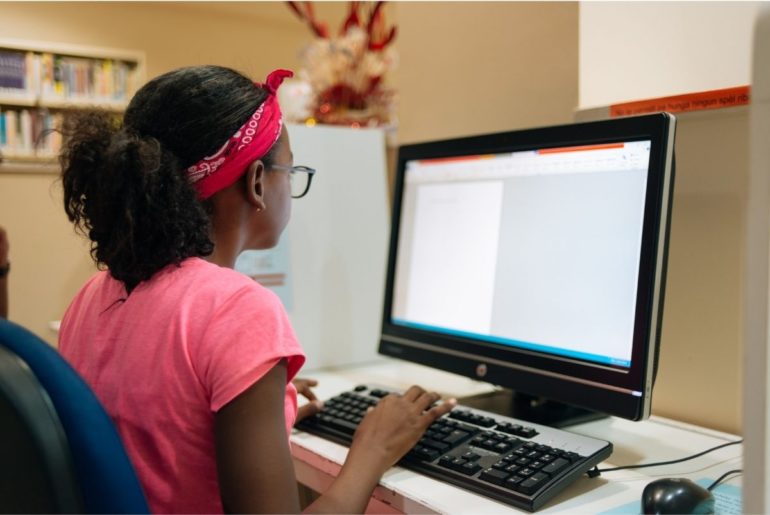With the new school year getting off the ground, a lot of kids and their families are adjusting to some sort of virtual learning. Whether virtual learning has meant more technology usage than your child is used to or a less structured, more independent learning environment for your child, this year might feel like a totally new way to be in school. From Kindergarten to high school, chances are kids will struggle with motivation at some point this fall. Here are some tips to help you help kids of all ages stay healthy, engaged and motivated as they navigate virtual learning.
Start with the body basics.
For kids of any age (but particularly those under 8), physical activity is non-negotiable. Especially as kids transition from summer to school, it might be challenging to fit in enough play time and exercise. Help kids make a plan for getting the wiggles out — before, during and after they plug in. Plan recess into their virtual day, and think about what kinds of physical rituals your kid can do to shake off the school day when they’re finished.
Also, try to make sure your student is body-ready to learn. That means, remind them to hit the bathroom before getting online! Also, did they eat breakfast? Do they usually snack at a certain point in the day? You can help them stay ahead of these basics with a ready-to-learn checklist that you create together.
Set the expectation that “school” is still school.
Sure, “school” might be happening in the most quiet corner of your home (if there is one at all), and with less than ideal acoustics. And, sure, it’s possible that your kid hasn’t worn shoes in months and insists that it doesn’t matter if they’re wearing their pajamas to class. But the more you can do to help your kiddos approach learning with the same interest and curiosity as they bring to in-person instruction, the more engaged your child is likely to be. For example, the social aspects of virtual learning will be a great motivator for a lot of kids. Talk to them about their teachers, what they worked on and learned each day, and find out who else is in their classes. Consider having a regular “lunch hour,” requiring your child to be dressed in real clothes by a certain time in the morning, and stick with other habits they’d observe in in-person school.
Talk to kids about how it’s going.
Lots of schools and teachers are new at virtual learning, and might not nail it right from the start, even with all their hard work. Our kids are probably going to make judgments pretty early on about how “good” their virtual instruction is, based on how well their teachers engage them—which can impact how well they engage with virtual schooling for the rest of the semester. Talk to them about it. Get their opinion, listen to them, and remind them that this is new for everyone, including teachers. Also, let them know that Zoom fatigue is real! They might notice that they feel tired or irritable after long spells of interacting virtually.
On the other hand, here might also be aspects of virtual learning that bring out new curiosities or learning strategies for your kid. They might really enjoy setting their own pace, being able to learn without distractions from classmates, or not having to deal with peers’ drama quite so much. It’s important to listen to them and understand what’s hard for them, but also help them appreciate what’s working well.
Help kids stay organized.
With no teacher in the room to make sure homework assignments are written down and calendars are updated, your kids might need your help to stay organized. If your kid is typically a shove-it-into-the-backpack kid (permission slips that never see the light of day?), ask them to show you what they did each day. Talk about homework or projects, and discuss a schedule for getting things done. If your kid’s school sent them home with packets or printed materials, you might need to get your hands on some multi-colored folders so that they don’t end up in a confusing pile. Even though they aren’t packing a backpack, make sure your kiddo has what they would typically have in their pencil case — the right pens and pencils and erasers and sticky notes so that they can find their groove.
Teach kids to take frequent breaks throughout the day.
If virtual learning means kids are on the computer for long stretches of time each day, taking frequent breaks is an essential mind-body habit. According to Dr. Laura Markham, young kids might need a break every 15 minutes and older kids should get up and move around every 30 minutes. Movement breaks give the mind a chance to reset and are a great way for kids to release frustrations and fatigue from their bodies and come back to learning more calm and energized.
Dr. Markham also recommends taking laughter breaks throughout the day. When we laugh, it actually changes our body chemistry by reducing the stress hormones in our bodies. This can help kids relax, and make sure they’re ready to learn. So encourage your kids to let their silly out (because it’ll probably make you laugh, too).
Remember that we’re all in this together.
Depending on their age, kids likely have some understanding of the Coronavirus pandemic and the public health risks that it has brought. Our kids want to do the right thing and feel good about themselves when they are helping others. So remind your kids that they are doing their part to stop the spread of the virus by learning from home instead of in big groups at school. Kids all over the country and the world are facing disruptions to their typical school experience. When you see stories or photos showing a new innovation in learning that’s helping kids learn in new and exciting ways, share them with your kids! It helps us all to remember that we’re all in this together and that virtual learning is one way that kids can help take care of others right now.







